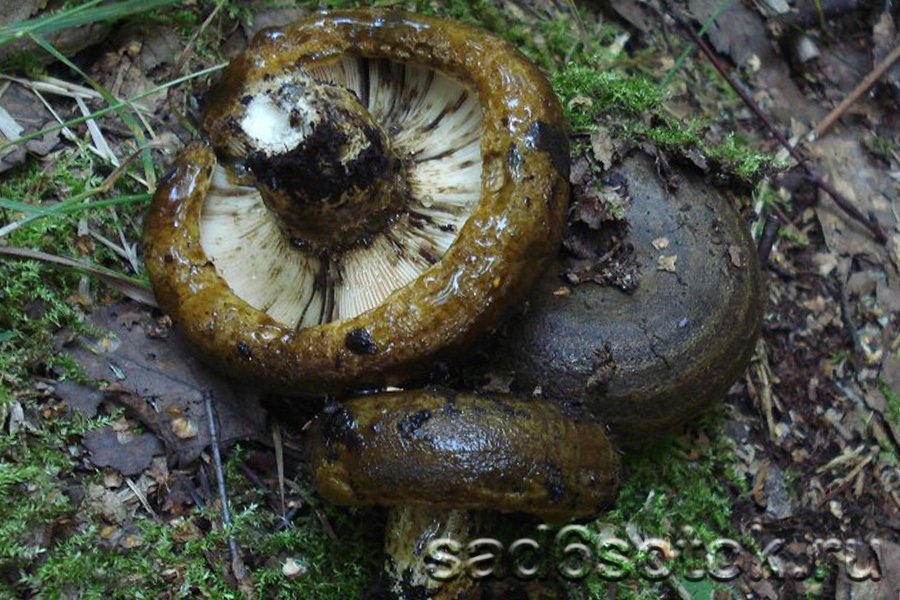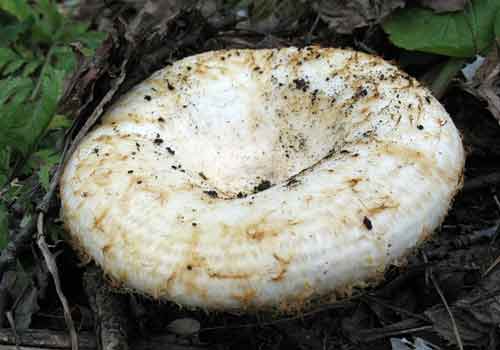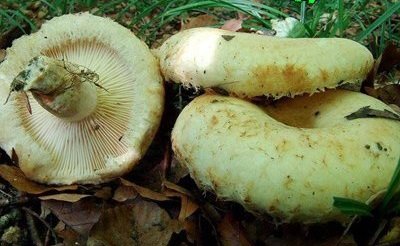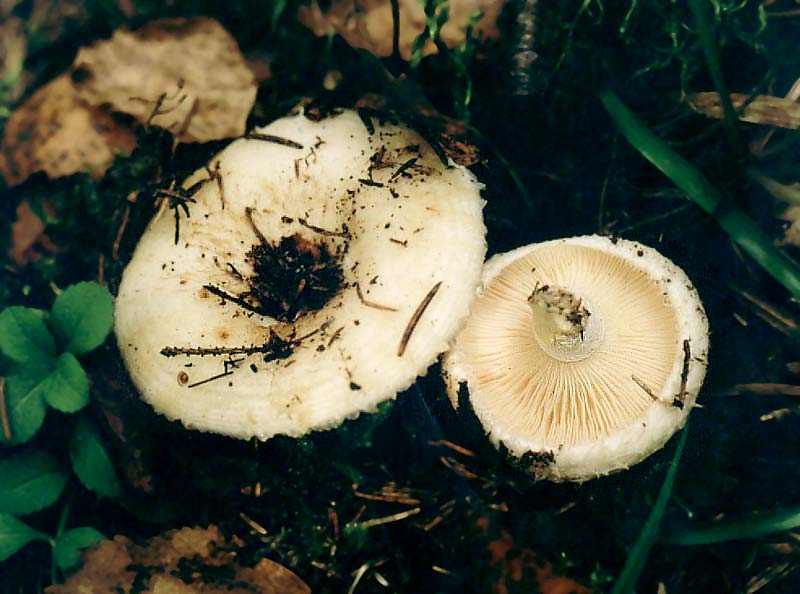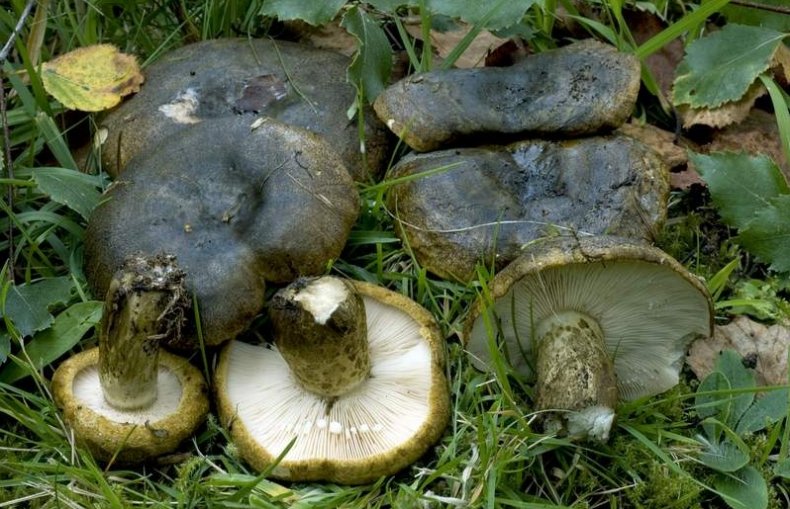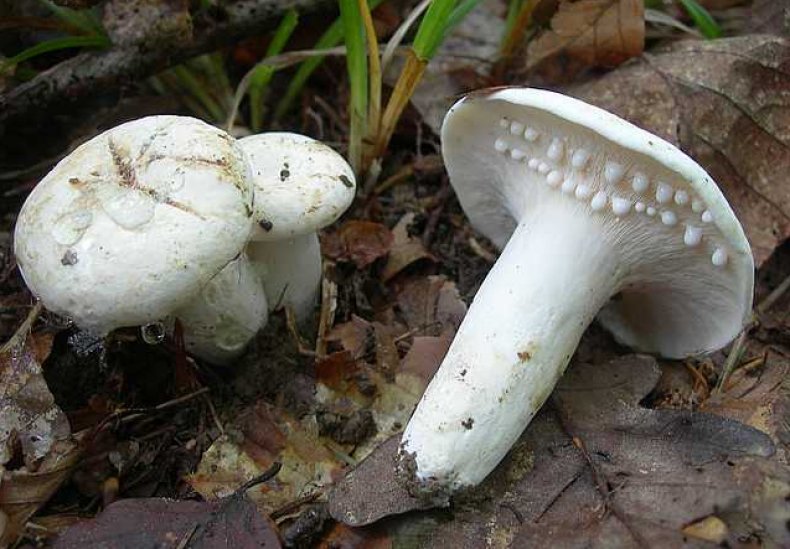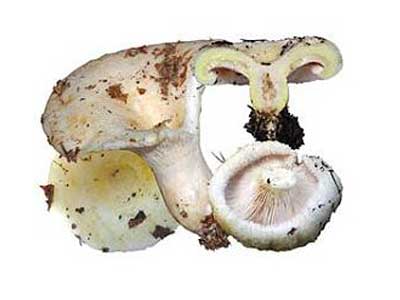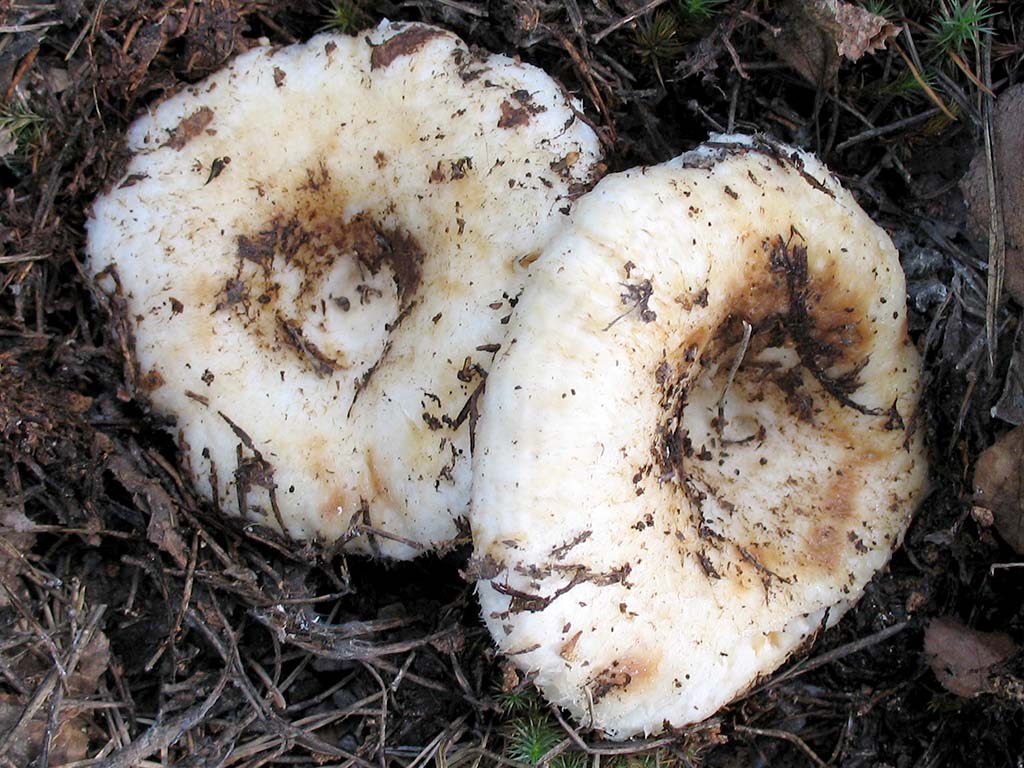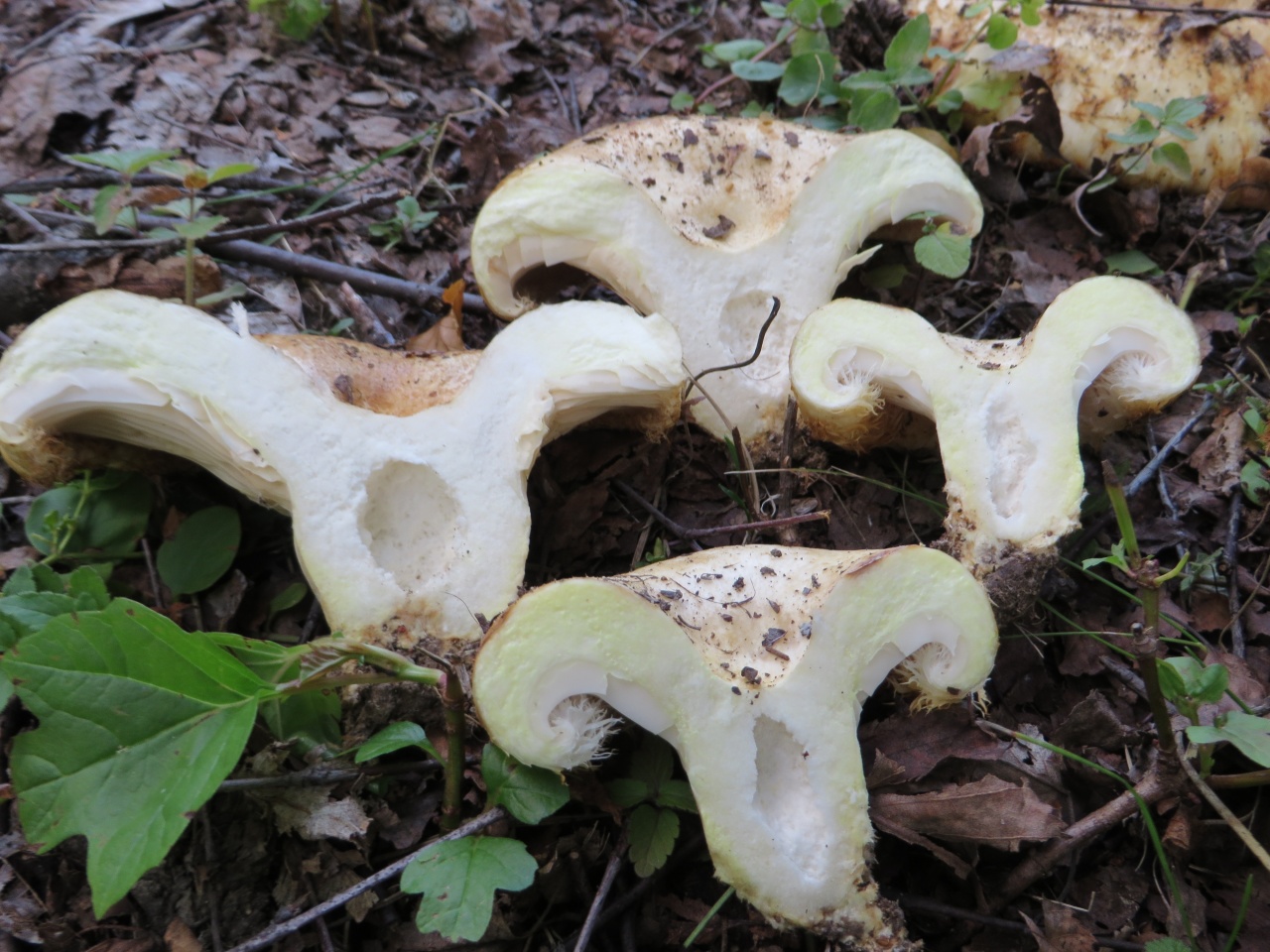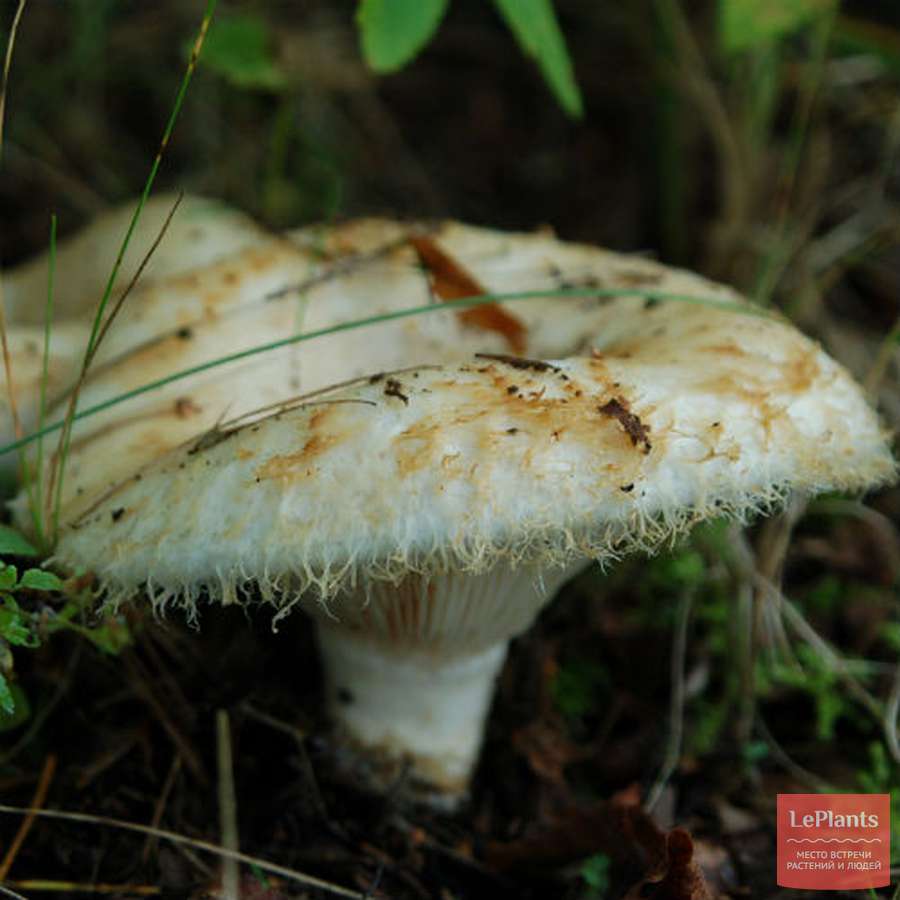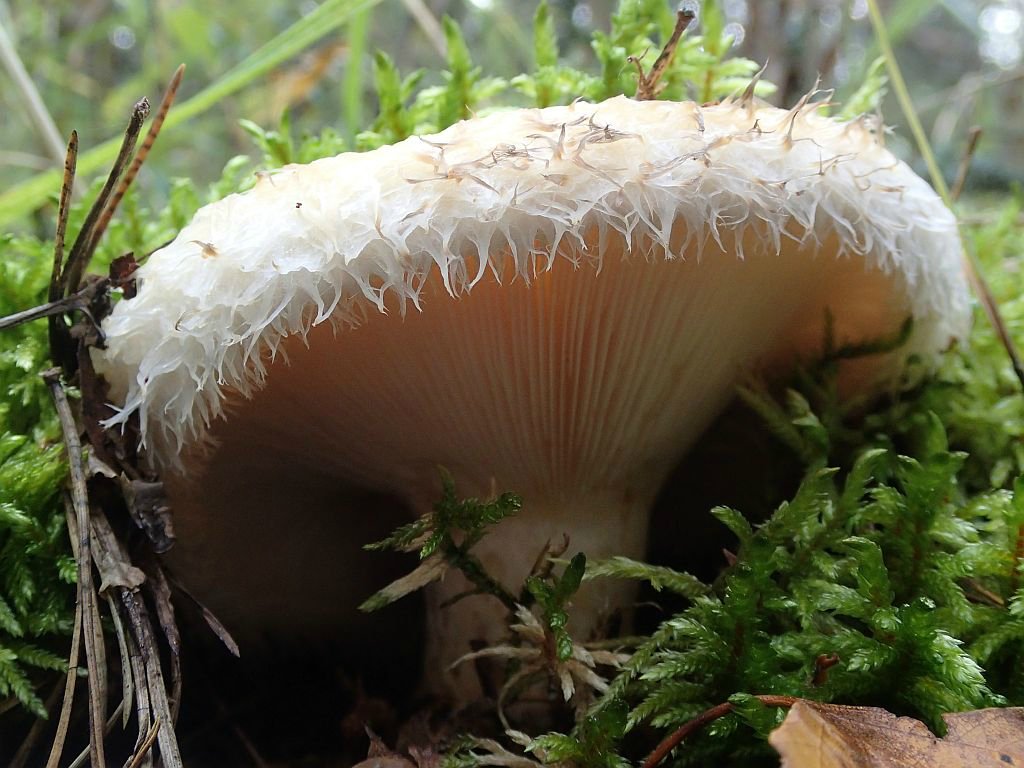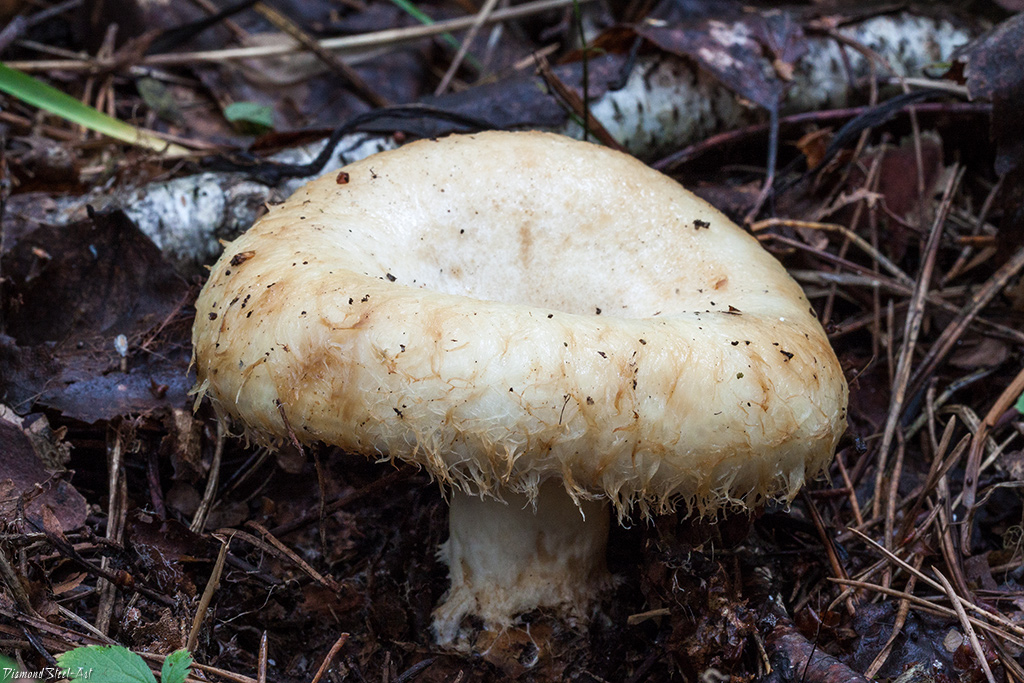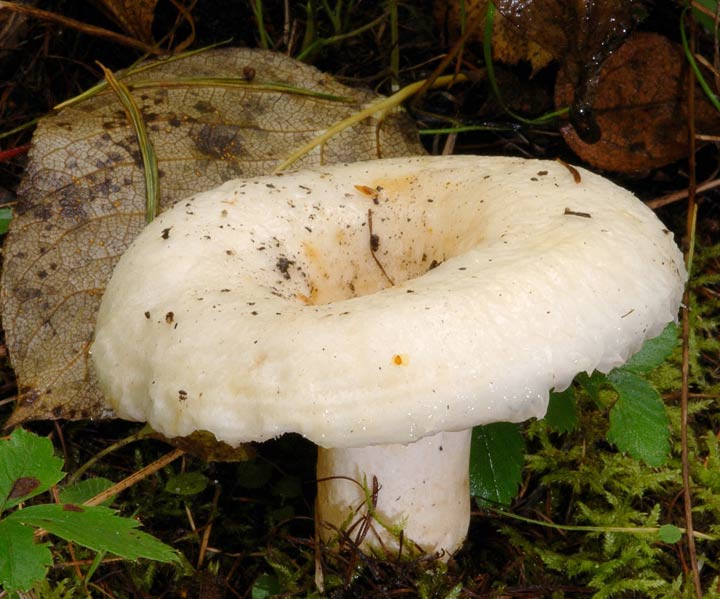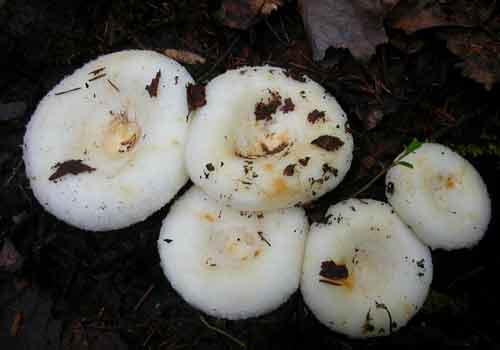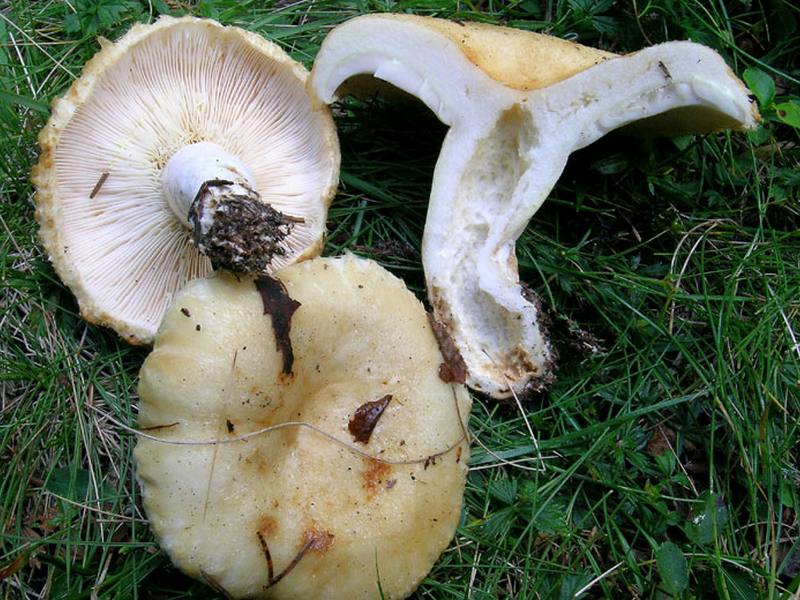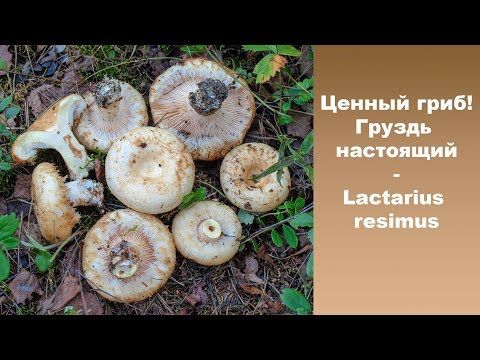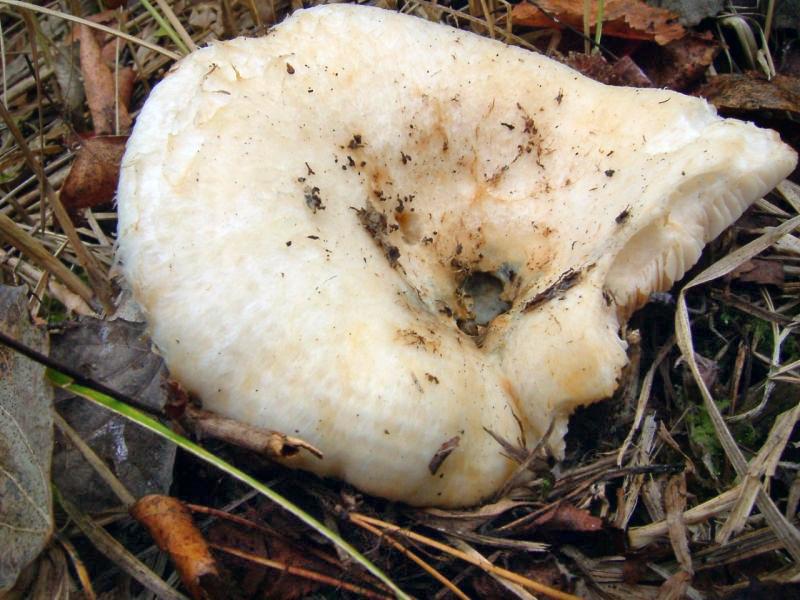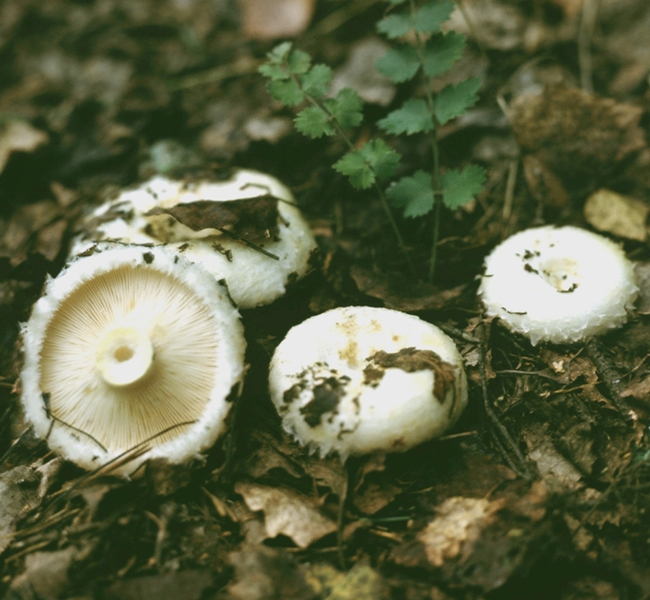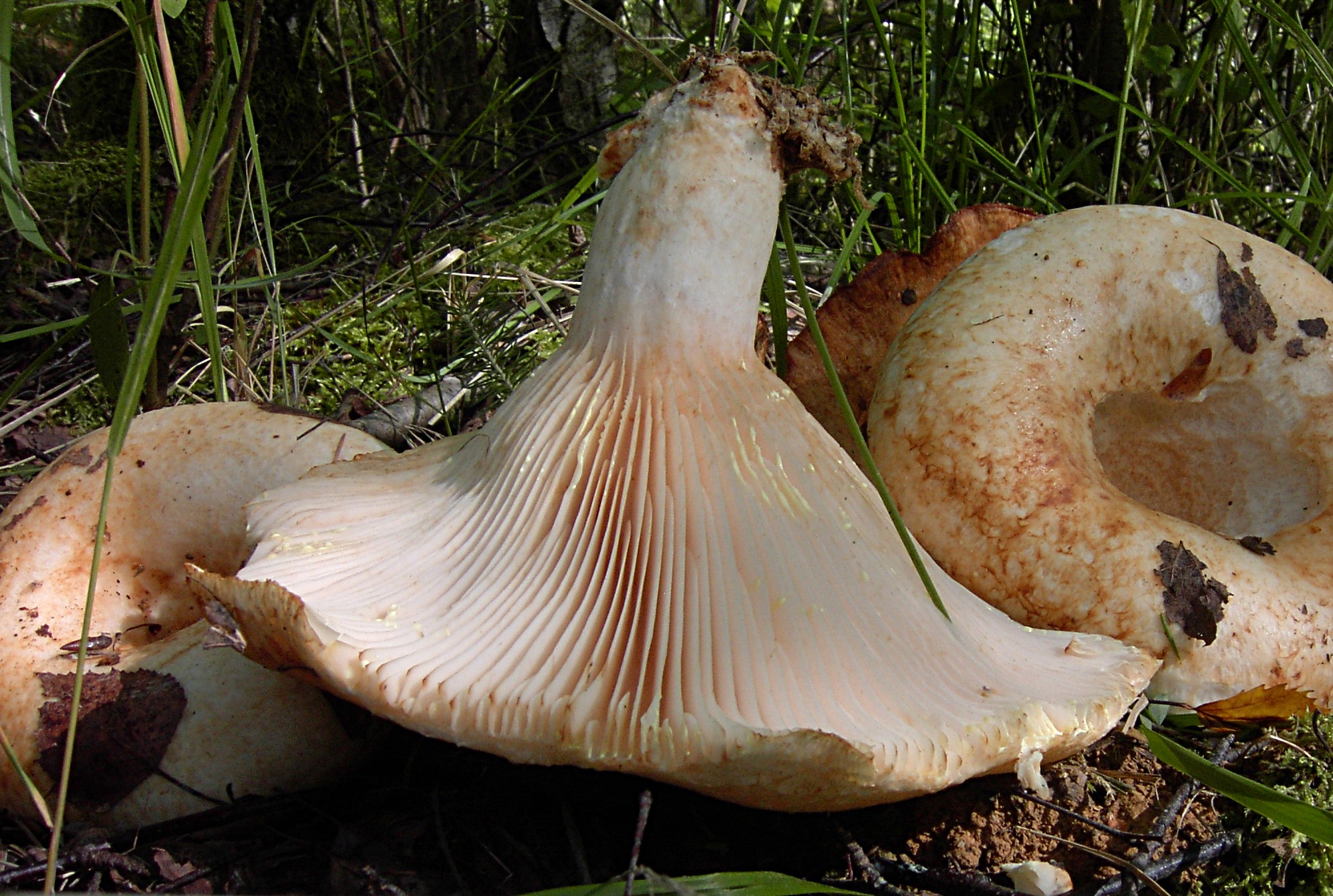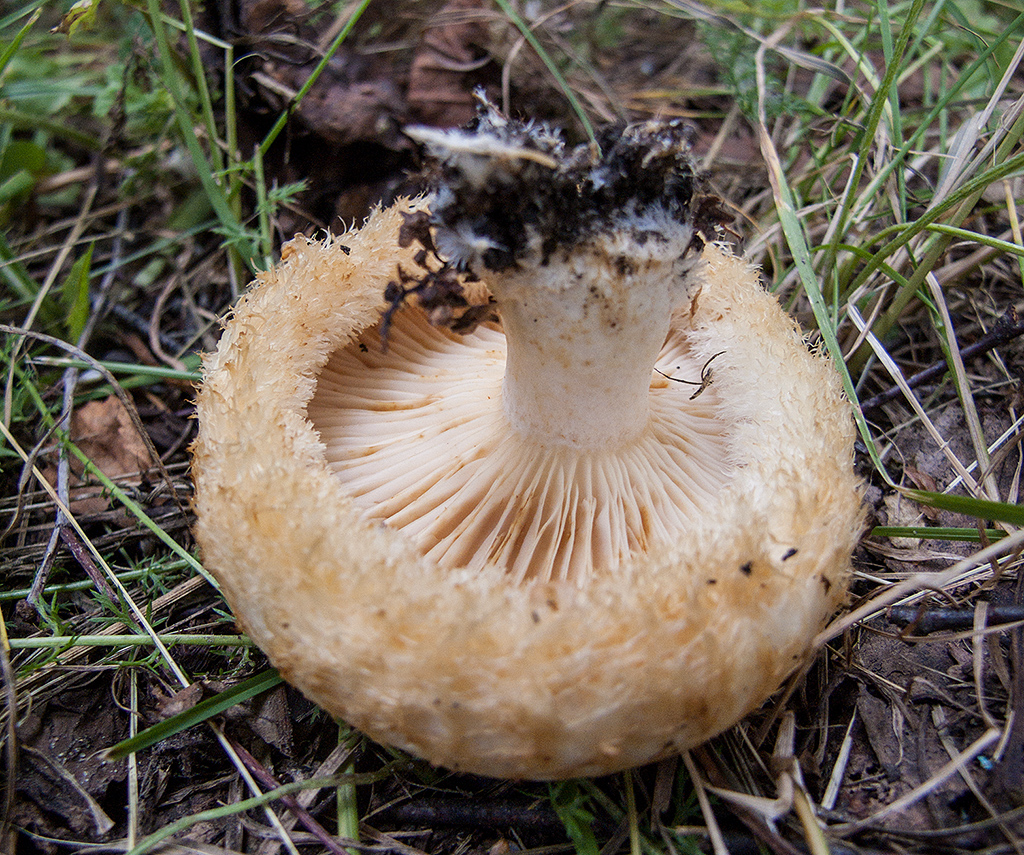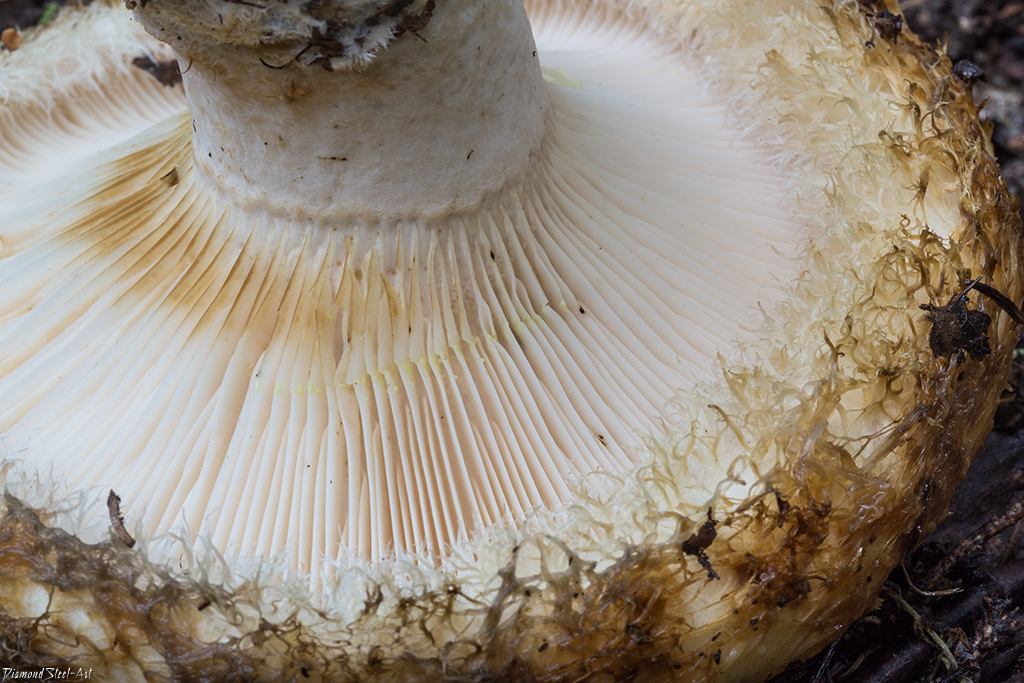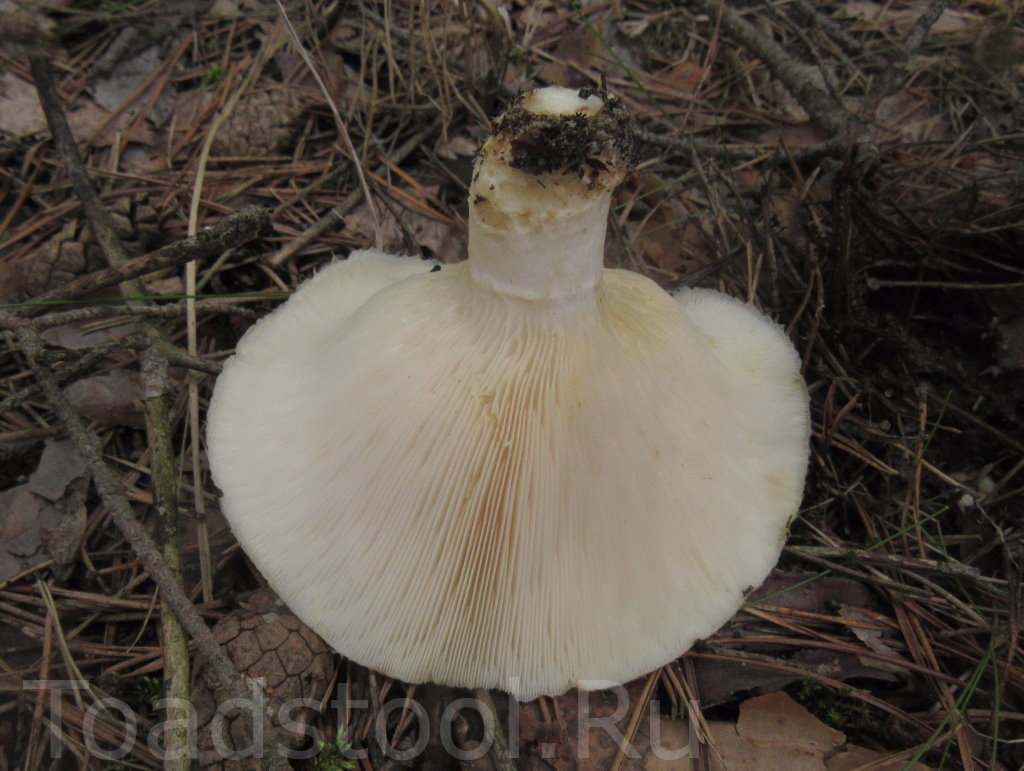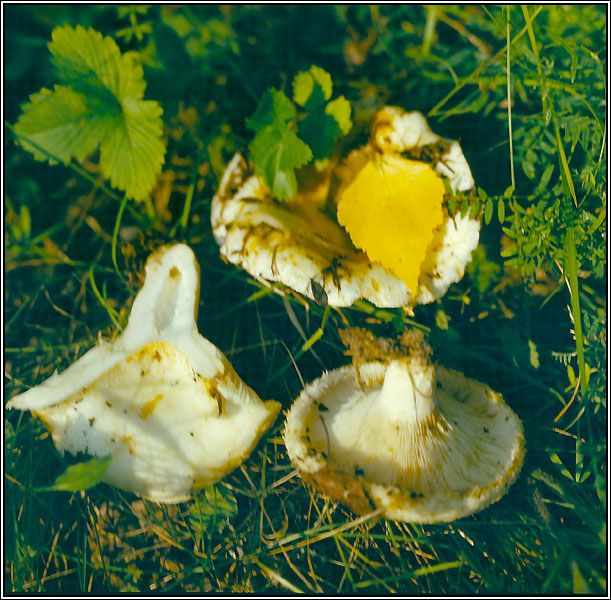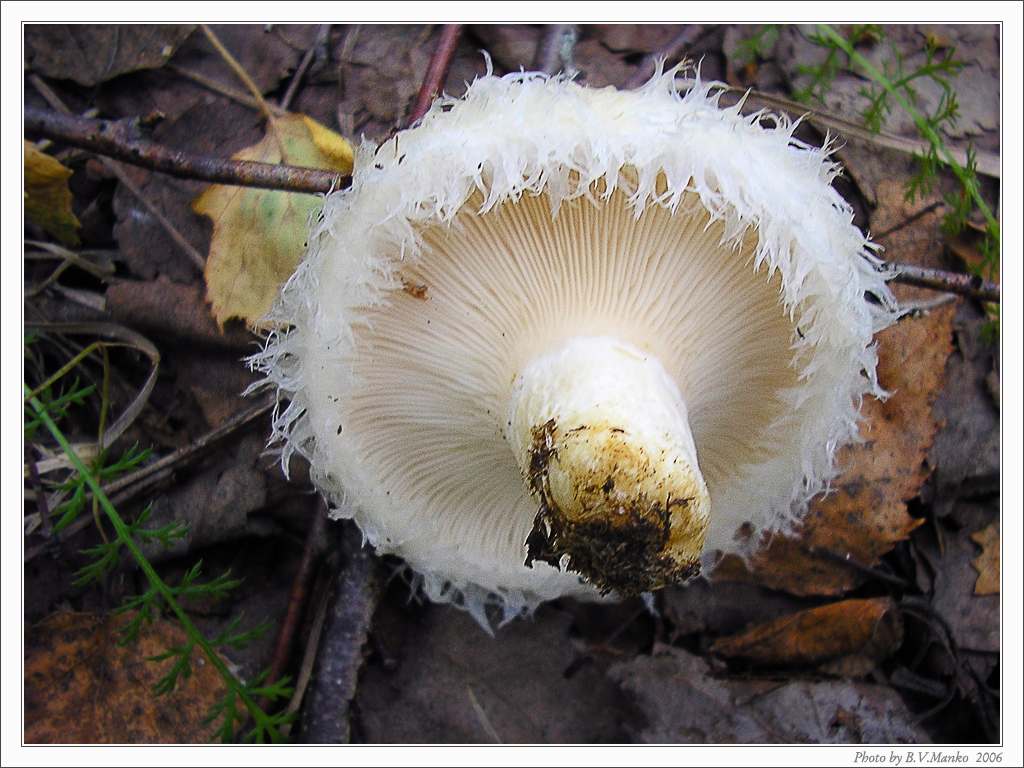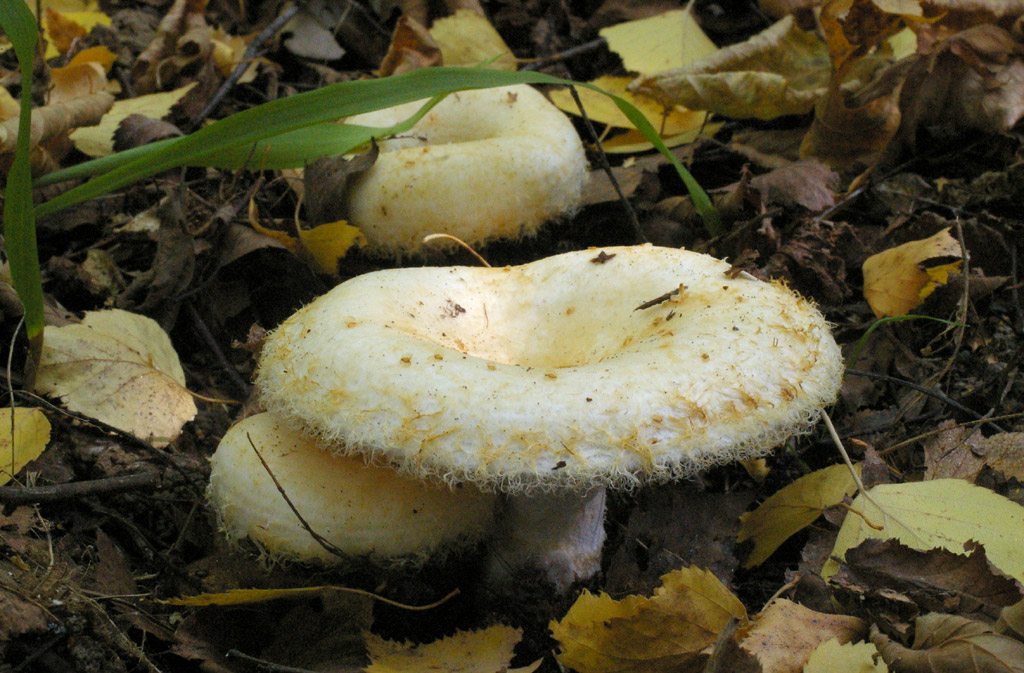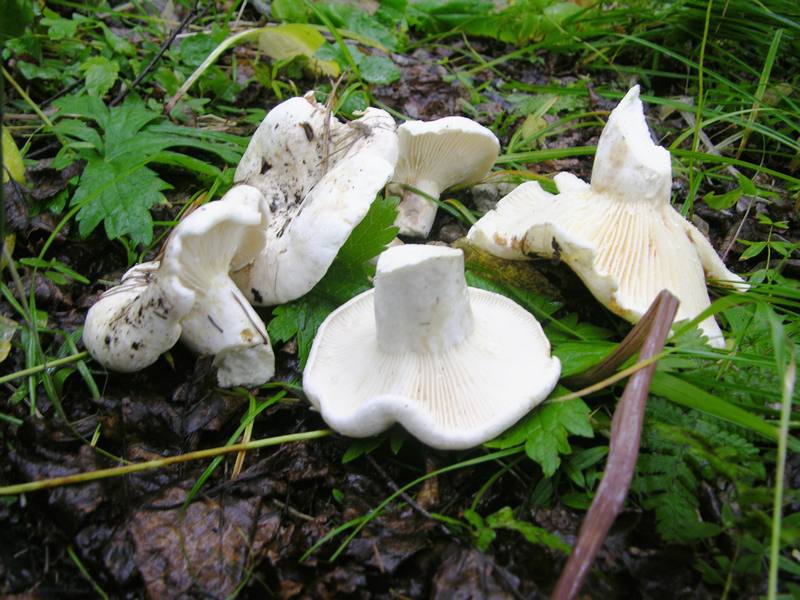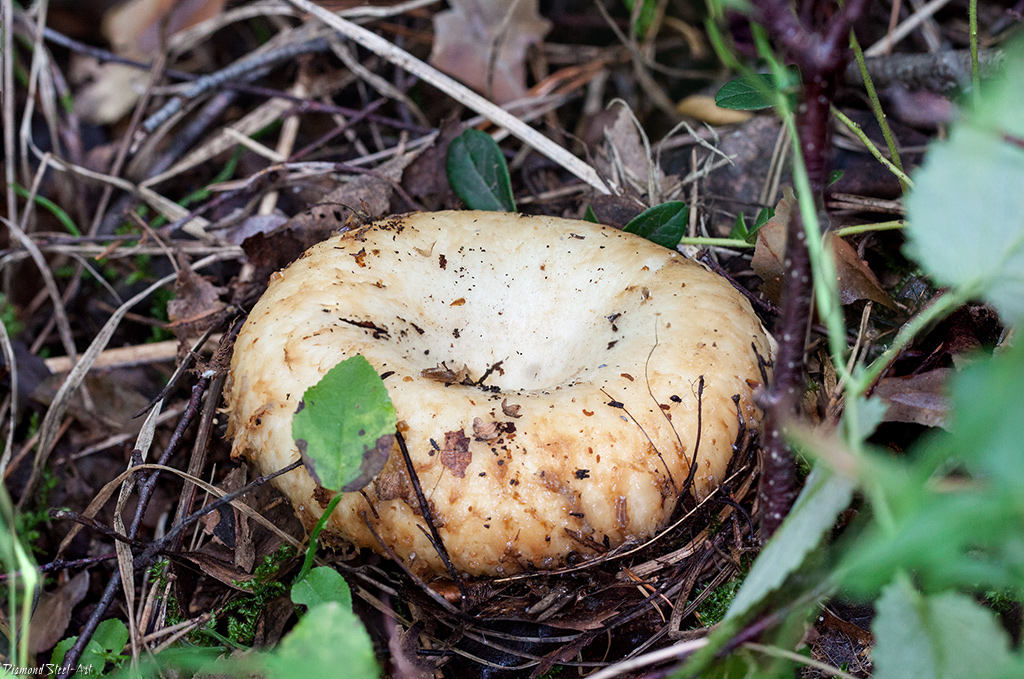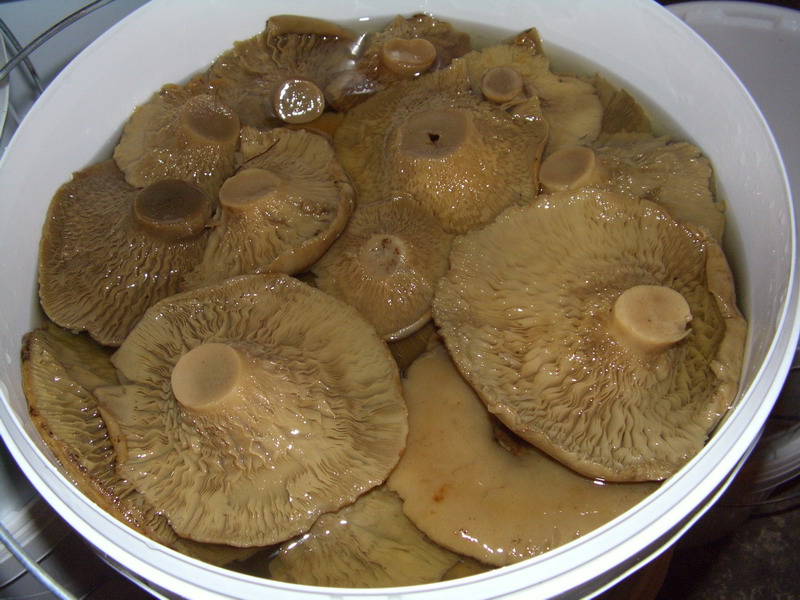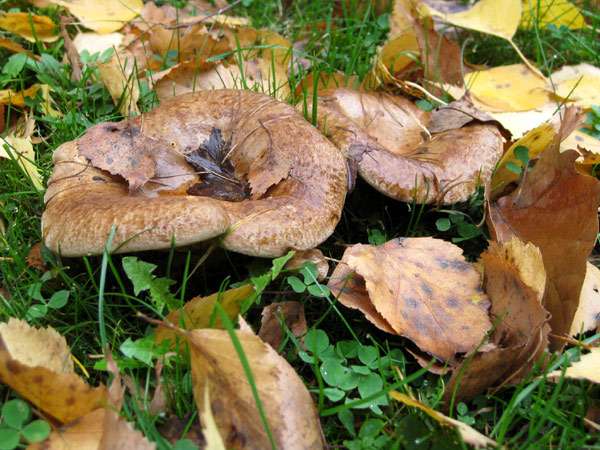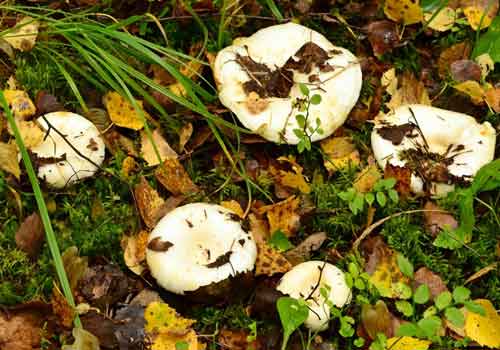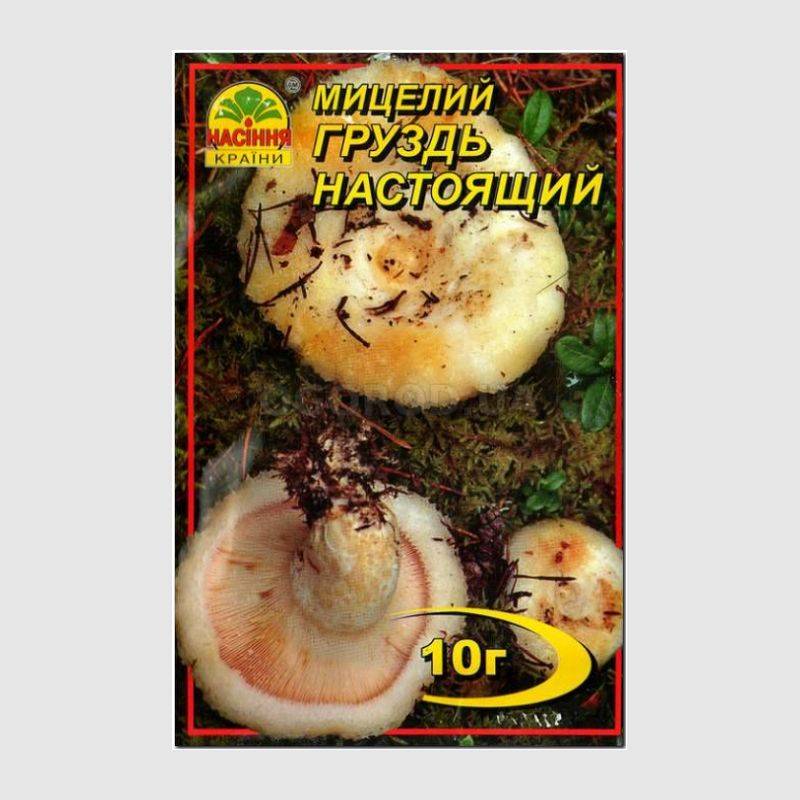Pepper Milk, Lactarius piperatus
Hat: Matte white, dry, 8-15 cm in diameter, fleshy, dense, first flat-convex, then funnel-shaped, with a curled edge, without concentric zones. The pulp is dense, white, without a special smell, spicy peppery taste, it emits a white acrid juice that does not change color in the air or turns yellow a little.
Hymenophore: The plates are white, very frequent, narrow, branched, descending along the pedicle.
Spore powder: White.
Leg: Up to 8 cm long, 1-3 cm thick, dense, solid, smooth, white, slightly narrowed at the bottom.
Spreading: Pepper milk is found from July to October in oak, birch and mixed forests, forming a mycorrhiza with many deciduous trees, including hazel.
Similar species: There are not so few strong milkmen with light-colored caps. The violin (Lactarius vellereus) is quite similar to the pepper mushroom, differing from it, however, in rare plates. The parchment mushroom, Lactarius pergamenus, is characterized by a wrinkled cap. The glaucous milk mushroom (Lactarius glaucescens), unmistakably stands out for its bright reaction to KOH and blue (far from immediately) milky juice. Based on the descriptions and without personal experience, the pepper mushroom can even be confused with the aspen mushroom, Lactarius controversus, but the similarity between these mushrooms is only formal.
White (Russula delica), beloved by many podgruzdok, is very similar to pepper milk mushroom. This representative of russula differs from the lactarius in the complete absence of milky juice, but in order to learn to distinguish these mushrooms in a non-contact way, experience is needed.
Edibility: In our literature, it is considered “conditionally edible”. Perhaps, the pepper milk mushroom along with the indistinguishable violin is just the case when one can agree with foreign "experts". Mushrooms are virtually inedible.
Author's notes: Every family has its black sheep. Among the milkmen, there are mushrooms with such an unyielding will that they absolutely do not lend themselves to re-education. Whatever you do with a violin or pepper load - you can't eat them. More precisely, you can - but only if there is nothing else.
In some places, you can find indications that pepper milk provides growth hormones to partner plants (oak, birch, etc.), which makes symbiosis extremely productive. So the human assessment of this mushroom, based on gastronomic characteristics, looks kind of narrow, like, for example, a hamster.
In old age, pepper mushrooms become difficult to distinguish from any other white wooden lactarius, and even from a white load. However, if someone really had to distinguish between them, people would come up with something.
Does it turn blue, does it not turn blue? The change in the color of the milky sap in the air, or the difference between this change, makes it possible to distinguish the parchment milk mushroom from the very similar glaucous milk mushroom (Lactarius glaucescens).
Similar species and how to distinguish from them
Porcini mushrooms are similar to some mushrooms of the same family. Among the doubles are yellow milk, pepper, violin and others. But you should not be afraid of a mistake - they are all conditionally edible and are prepared using a similar technology. The ability to distinguish white milk mushrooms from false ones will come in handy, since they are different in taste.
The violinist is the most similar of the doubles. And the color, and the size, and the ratio of the cap and the leg are the same. But the violin forms mycorrhiza mainly with beech (can be found under oak trees); the edges of the cap are not pubescent.
The milky juice of the peppercorn does not turn yellow in the air, but turns green. His hat is smooth and velvety.
Aspen mushroom loves more humid places; it will never grow next to white, preferring shaded aspen groves to birch groves.
Another double is a white wave, which is easy to distinguish by its smaller size and "fluffiness".
Well, white podgruzdok does not have milky juice.Despite the apparent similarity, all doubles have clear differences. It is enough to see once what a white milk mushroom looks like, and you will not confuse this mushroom with anything.
How are these intoxications classified?
In case of poisoning with mushrooms, doctors distinguish two types of the course of intoxication:
- general or acute - with the presence of all signs typical of food poisoning;
- local - with symptoms limited to intestinal disorders.
Of course, the division of diseases according to their severity is also relevant. As with poisoning with other products, in the case of this intoxication, the person's condition can be serious. The severity of the symptoms experienced is influenced by many things, for example, the presence of alcohol in the stomach. In combination with alcohol, the symptoms appear more acutely and earlier.
It does not affect the severity of the symptoms and the speed of their manifestation by what kind of a person was poisoned by mushrooms, black or white. But there is a dependence on whether the stomach is filled with pickled mushrooms or salty ones. Salted pickles are much less common, especially if oak leaves were used for pickling.
The vinegar used for pickling preserves not only the mushrooms themselves, but also all pathogenic elements that can get into conservation. For example, dirt particles, dirt from hands or from a can, if sanitary requirements are not observed when preparing homemade preparations, microscopic eggs of parasites and insects that may be caught between the plates under the cap.
Description of mushrooms
False milk mushrooms are a welcome guest on the festive table, but not all housewives take up the preparation, preferring more familiar types. The reason for this is the white milky juice contained in the cap and leg, which can take on a yellowish tint in the air and has a pungent bitter taste.
Real white milk mushrooms are considered the best for pickling.
Etymology of the name
There are different versions:
- The mushroom is so named because of its high weight, at which it seems heavy and bulky.
- The origin comes from the word "pile", which means a lot.
Both options have the right to life, since some individuals reach decent sizes, massive due to the abundance of juice in the cap.
Peculiarities
Milk mushrooms grow in heaps or paths. Having found one specimen, you can be sure that you cannot go home without prey, you just need to carefully inspect the surrounding area.
The average temperature for the growth of mushrooms is 7-10 ℃. According to old mushroom pickers, it is best to start "hunting" for this mushroom after long, but not heavy rains. A stick and a sharp knife are useful for collecting.
They choose sunny meadows as habitats and do not hide in the shade. After rain, the cap becomes slippery, like an oil, and the shape is always slightly concave, funnel-shaped.
Fruit bodies contain vitamin D of non-animal origin, and are also saturated with a high protein content (up to 30%), such an amount can replace meat.
Beneficial features
Mushrooms are recommended for dieters. Also, eating them regularly helps:
- make up for the deficiency of minerals;
- increase immunity during epidemics and with the threat of tuberculosis, since the composition contains substances that resist Koch's bacillus;
- stabilize the state of the nervous system;
- improve digestion;
- activate the process of removing slags.
All milk mushrooms, including false ones, must be soaked to remove the bitterness from the milky juice. The difference in processing time is dictated by the characteristics of a particular species.
Nutritional qualities, benefits and harms
100 g contains:
- 1.8 g protein;
- 0.5 g fat;
- 0.8 g of carbohydrates.
Calorie content - 16 kcal.
Vitamins of group B, which are found in abundance in all milkmen, serve as the prevention of depression and neurosis. Other substances contained in them are useful for patients with tuberculosis - they neutralize the bacteria that excite it (which, of course, has found application in pharmaceuticals).
Also, milkmen help with kidney failure and urolithiasis, neutralize many toxins and serve as a diuretic. Due to the fact that, with a high nutritional value, they do not contain much glucose, they are often advised to be included in their diet for diabetics.
The poplar mushroom, however, also has a number of harmful properties. Firstly, when using an improperly prepared mushroom, you can get poisoning (this is due to the milky juice contained in its pulp). Secondly, even if the mushroom is cooked correctly, it is rather poorly digested. Therefore, in large quantities, milkmen, like other mushrooms, are not recommended to be consumed. It is especially harmful for those suffering from stomach ulcers, gastritis or other diseases of the digestive system.
As you can see, collecting aspen mushrooms is not devoid of sense: in salted form, they are edible and bring noticeable benefits to the body. They are also very nutritious, so vegetarians can eat them instead of meat.
Beneficial features
Highly nutritious fleshy mushrooms are rich in easily digestible proteins, carbohydrates, minerals and vitamins. The protein content in the fruit bodies is high - up to 33 g per 100 g of dry matter; in boiled form, they can be successfully used in dietary nutrition as a substitute for meat or fish.
B vitamins, carotene and ascorbic acid, which have a positive effect on the functioning of the nervous system, the stability of the immune system, and the work of hematopoietic organs, are significantly represented.
Mushrooms, unique in their kind, contain the active form of vitamin D, in a similar form it is found only in animal products. This essential element is essential for the prevention of osteoporosis, maintains healthy skin and hair, and directly affects the absorption and balance of calcium and phosphorus.
Minerals present in fungal tissues - sodium, magnesium, calcium and phosphorus - are in an accessible form, are quickly absorbed and replenish the content of these substances in the body.
Active antibacterial substances that inhibit tubercle bacillus have been found in the composition of the pepper milk mushroom; its positive effect in the treatment of kidney diseases, in particular, urolithiasis, is also known. These healing properties are widely used in traditional medicine.
During the preparation of pickled pickles, during fermentation with the participation of lactic acid, special substances are produced that have an anti-inflammatory effect and lower cholesterol levels.
Where they grow, in what forests and how to collect
The chance to find a mushroom increases in perennial forests, mainly of mixed type or birch forests. A favorite place is high thickets, near birches, aspens, firs, pines and oaks. The search for the weight is difficult due to the dark shade of the cap, which allows you to disguise yourself among foliage, moss or simply on damp ground. Nigella loves moisture and sun, so it is often found near water bodies, on hills and places abundantly covered with moss.
Mushrooms are common in the forests of Transbaikalia, Western Siberia, Karelia and central Russia. They are also found on the territory of Ukraine, Belarus and Moldova. The mass collection falls on August - September, however, they begin to appear singly already with the arrival of July. Nigella is resistant to cold, so you can collect them until the first snow.
Note! You need to go to the forest after light rains, which are enough for the mushroom to reach its ideal size (no more than 8 cm). An overripe lump becomes too bitter, wormy and loses its attractiveness. The ideal mushroom is of medium size, firm flesh, and a whole shell.
The rules for collecting pigs are no different from other species. It is forbidden to uproot forest products, as the restoration process becomes impossible. You need to carefully cut off the nigella at the base. A sharp folding knife is suitable for these purposes. Place mushrooms in wicker baskets or plastic buckets.
Important Tips
So that walks in the forest with the collection of saffron milk caps do not turn into serious consequences, you should be guided by some tips:
- you can cook mushrooms only in the first 12 hours after collecting them;
- do not use pickled mushrooms in jars with a swollen lid or with a cloudy brine;
- do not purchase canned mushrooms on the market;
- store mushroom pickles in a dark, cool place with a room temperature of no more than 15 degrees;
- the concentration of toxins is reduced by boiling saffron milk caps in water with the addition of vinegar or citric acid.
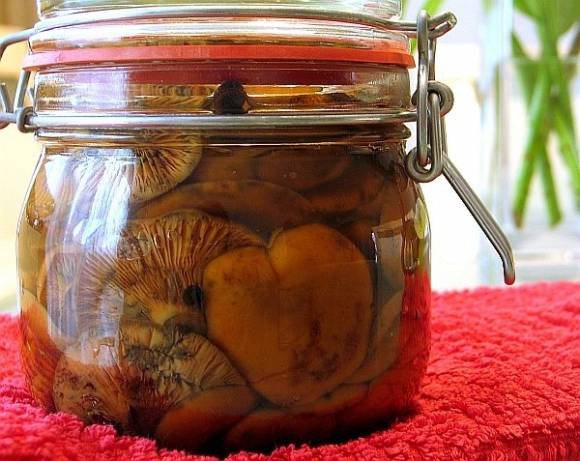
Swollen lid - canned food in the trash heap
Having dealt with the causes of mushroom intoxication, we give an answer to the question, is it possible to get poisoned with salted mushrooms? Yes, if all of the above rules were not followed during conservation.
At the first onset of symptoms, seek medical help, you cannot hope for a case: "maybe everything will go away by itself"? Especially when it comes to pregnant women and children. The video in this article will tell you about the possible consequences of mushroom poisoning.
Description and distribution of aspen (poplar)
All milk mushrooms are outwardly similar to each other. Many people know these mushrooms by the proverb “he called himself a load - climb into the back”. But in it, rather, we are talking about a real mushroom - the most valuable conditionally edible mushroom, which has long been intensively collected by mushroom pickers. Other representatives of this genus are less known. One of them is the aspen milk mushroom, which is quite rare and less popular than the real one.
Description
Aspen milk mushroom (Lactarius controversus) is a mushroom of the Russulaceae family, of the Millechnik genus (Lactarius). In another way, it is called poplar mushroom.
- The cap is fleshy, whitish in color with light pink spots, at a young age it has edges strongly curved downwards and a depressed middle, later it straightens out, becomes widely funnel-shaped. The diameter reaches 7-20 cm. In wet weather, the surface becomes sticky and slimy, which is why it becomes covered with specks.
- On the back of the cap there are cream or light pink plates (an important identifying feature), weakly running down the stem.
- A short, thick leg - 2-7 cm in height and 1.5-4 cm in diameter - has the same color as the cap, or whitish, with yellowish spots. Dense, often narrowed at the base.
- The pulp is white, with a fruity odor and abundant acrid white milky juice, which does not change its color in the air.
The poplar mushroom belongs to conditionally edible - it can be eaten only with preliminary soaking, first of all in salted, less often - in fried and boiled form.
Spreading
Most often, poplar mushrooms can be found under poplars, aspens and willows, since with these trees they form mycorrhiza. They prefer moist warm temperate forests. In general, these mushrooms are quite rare. In Russia, you can find them in the Lower Volga region from July to October.
Similar species
Very often, aspen milk mushroom is confused with a white or whitewash (Lactarius pubescens). Distinguishing them is quite simple: the main difference is the pubescence of the cap. It is densely pubescent in the white beetle (“pubescens” means “pubescent”), but not in the poplar mushroom.
It can be distinguished from the real mushroom (Lactarius resimus), a more nutritious mushroom in terms of food, by its pubescence (the real one is pubescent at the edges) and the color of the underside of the cap (the real plate has white, not pink, like poplar).
Other lactarius (representatives of the genus Lactarius), such as the violin (Lactarius vellereus) or pepper milk mushroom (Lactarius piperatus) are also sometimes confused with the aspen milk mushroom, none of them has the underside of the cap painted pink, so it is not difficult to distinguish them.
Primary processing and preparation
As already mentioned, aspen milk mushrooms are conditionally edible, therefore they require special preparation before use. Most often they are salted. The correct cooking technology is very important: if you do not follow it, the mushrooms will be bitter due to the milky juice contained in their pulp.
Before cooking, aspen milk mushrooms should be soaked in cold water, changing it as often as possible to prevent fermentation and souring. The water should cover the whole mushrooms. With frequent water changes, one or two days of soaking is sufficient. After that, you need to rid the mushrooms of the wormholes, and then boil for 10 minutes. Less commonly, fried aspen milk mushrooms are used.
Nutritional qualities, benefits and harms
100 g contains:
- 1.8 g protein;
- 0.5 g fat;
- 0.8 g of carbohydrates.
Calorie content - 16 kcal.
Vitamins of group B, which are found in abundance in all milkmen, serve as the prevention of depression and neurosis. Other substances contained in them are useful for patients with tuberculosis - they neutralize the bacteria that excite it (which, of course, has found application in pharmaceuticals).
Also, milkmen help with kidney failure and urolithiasis, neutralize many toxins and serve as a diuretic. Due to the fact that, with a high nutritional value, they do not contain much glucose, they are often advised to be included in their diet for diabetics.
The poplar mushroom, however, also has a number of harmful properties. Firstly, when using an improperly prepared mushroom, you can get poisoning (this is due to the milky juice contained in its pulp). Secondly, even if the mushroom is cooked correctly, it is rather poorly digested. Therefore, in large quantities, milkmen, like other mushrooms, are not recommended to be consumed. It is especially harmful for those suffering from stomach ulcers, gastritis or other diseases of the digestive system.
As you can see, collecting aspen mushrooms is not devoid of sense: in salted form, they are edible and bring noticeable benefits to the body. They are also very nutritious, so vegetarians can eat them instead of meat.
Distribution locations and collection times
Most often, these mushrooms grow in large groups, families or, as mushroom pickers say, "flocks" in late summer and autumn in deciduous or mixed forests.
The real milk mushroom is a common species, it is found quite often in light deciduous or mixed forests, in lindens and birches. It settles in small meadows, and sometimes in rather large colonies. The best soils for its development are with white clay that comes close to the soil surface. Mushrooms are harvested from July until the very frost. Connoisseurs especially appreciate autumn harvests - the fruit bodies are not so well stored, but they also do not have a pungent bitterness.
Under the thin aspen trees, according to its eloquent name, there is an aspen mushroom, forming neat glades, not far from one another, fused in the form of chain links. He loves to settle at the root system of poplars of various types, often growing in poplar plantations and forest belts. The collection time is only two months - August and September.
Spruce forests have chosen a bright yellow mushroom - under the thick paws of dark firs, small tight groups of these mushrooms grow, less often it forms whole glades. Harvested in late summer and early autumn.
The oak mushroom grows in numerous families in oak forests, prefers soft calcareous soils, settles in abundance on the slopes of warm, sun-warmed hills. Tight greenish fruiting bodies of this species are found from the end of summer to the very frost.
Individually or in large groups in birch groves, the black mushroom lives
Collect it, carefully cutting off a short leg, during the period of the mass offering - from mid-July to the end of summer
White podgruzdok grows singly or in clearings in oak groves, birch and mixed forests. The beginning of the collection falls in the middle of summer and lasts until September.
Milk mushrooms:
What are milk mushrooms, a photo and a description of how to cook, what medicinal properties they have, all this is of great interest to those who lead a healthy lifestyle, monitor their health and are interested in folk methods of treatment, including with the help of mushrooms. So we will try to answer these questions in the following article.
So:
Real milk (lat.Lactárius résimus) is an edible mushroom of the genus Millechnik (lat.Lactarius) of the russula family (lat.Russulaceae).
Despite their wide popularity, they hide a lot of surprises. For example, an interesting fact is that nowhere except in Russia and the countries of the former USSR is this mushroom considered edible, and in our country it belongs to conditionally edible mushrooms, since it certainly requires processing before use.
Distributed in Eurasia; in Russia - in the European part and in Western Siberia. The hat is fleshy, with age it becomes wide-funnel-shaped, with a rolled up fluffy or felt edge, to a diameter. 5–20 cm. The color of the cap and the thick, short stem varies from yellowish or green-white (in the case of the present) to greenish-black (in the case of the black lump). The pulp is dense, a burning milky juice is released at the fracture, yellowing in air. The plates adhere to the leg and go down slightly along it. Milk mushrooms grow in birch or pine-birch forests from July to September. They form mycorrhiza with coniferous and deciduous species. They are eaten only in salty form.
Milk mushrooms usually grow in families. They got their name for their massiveness, weight (weight). The mushroom is really dense, heavy, which is felt when filling the basket. Milk mushrooms love moderately wet weather, so the people say: "The rains are delayed - don't expect milk mushrooms." Among many types of milk mushrooms (aspen, oak, parchment, pepper, real, blue, yellow, black), the most common milk mushrooms are white, yellow and black.
The habitat of these mushrooms is deciduous and mixed forests. They prefer cooler areas and are often hidden from prying eyes by a layer of forest floor.
The word "lump" comes from the Church Slavonic word "gruzdie", which means "pile".
Perhaps mushrooms got this name because of the peculiarity of growing in groups, families. Some researchers believe that they got the name "milk mushrooms" as a result of their massiveness - weightiness. Since these mushrooms are rather dense and weighty in comparison with other species of the same genus: milky, volushkas, saffron milk caps, gray-haired mushrooms.
Milk mushrooms grow in groups, so if there is one, then the rest of the family is most likely hiding nearby.
These mushrooms become edible only after thorough soaking and boiling, after which they must be salted. Only pre-salted milk mushrooms can be used as an ingredient in any dish.
The most common types of milk mushrooms include:
White lump (aka real lump). The features of this mushroom are: a funnel-shaped cap with a pubescent edge, the skin of which is often decorated with pale concentric circles, a cylindrical hollow stem and brittle white pulp that secretes abundant milky juice.
The milk is black. The distinctive features of this species include: a sticky cap of a dark olive color, usually with a depressed center and a short stem of a lighter shade than the cap.
Peppermilk. The peculiarities of this mushroom are: the cap is white or with a cream shade, with a diameter of 5 to 20 cm. In the center it is covered with reddish spots and cracks. In young specimens, it has a slightly convex shape with tucked edges, later it becomes funnel-shaped, wavy along the edge. The surface is matte, smooth or slightly velvety.
The lactus is blue. The blue lump has a yellowish cap, velvety, shaggy at the edges. The pulp is dense, white, bitter in taste, the milky juice is white, but in the air it becomes purple in color.
Nutritional qualities, benefits and harms
It so happened that the real milk mushroom is considered inedible in Europe. In Russia, for its taste, he received a place among the mushrooms of the first category. True, its culinary potential is a little limited. White milk mushrooms are delicious pickled or salted. In frying or in soups, their dense pulp becomes excessively hard, and the taste does not fully unfold.
White milk mushroom is a mushroom related to high-protein products (35% of easily digestible protein in the composition), surpassing even meat in this parameter. It does not contain sugars, so it may be present in the diet of people with diabetes. Its inclusion in the dietary menu is also determined: with a low calorie content, it provides the body with the necessary substances.
A whole complex of minerals and vitamins, substances with antibiotic properties were found in the composition of this milk mushroom. The use of this mushroom in food helps to eliminate toxins, enhances immunity, tones up and raises the general emotional background (thanks to vitamin D). It should be remembered that beneficial properties are revealed only with proper processing. If a pungent milky juice remains in the mushroom pulp, it will have an unpleasant bitter taste and may cause an eating disorder.
Milk mushrooms are excellent pickling mushrooms. There is no need to be afraid of them. Despite the large number of doubles, a possible mistake does not entail serious consequences. In addition, it is enough to read the description of the present load, and you will not confuse it with anything. These mushrooms are easy to pick: they grow in large families, have dense flesh and are large in size. And with the taste of salted and pickled milk mushrooms, there is little that can be compared.
White Milk - Lactarius resimus
Written by Nikolay Budnik and Elena Meck.
White mushroom (raw, real) is highly valued among our mushroom pickers, sometimes even more than White mushroom. White lump is found on Ulom Zheleznaya much less often than porcini mushrooms, because it loves calcareous-clay soil, and our soils are mainly sandy-peaty. If you can meet other mushrooms by chance, then White Gruz cannot do without knowledge of mushroom places.
In Western books, White chest is called a mushroom of little value. The cool attitude of foreigners can only be explained by the fact that they simply do not know how to properly salt milk mushrooms.
There are many white millers. A distinctive feature of the White milk mushroom is its fluffiness and moisture, especially at a young age.
The “fur” can be very thick. The leg has spots characteristic of milk mushrooms. This can be clearly seen in our photographs. Another important identifying feature is the rapidly yellowing milky juice. White milk mushrooms grow to large sizes (20-25 cm in diameter).
In adulthood, the fluff dries up, and the top of the cap may turn yellowish. Much depends on wet or dry weather.
There is a rule - if you find one lump, look around it. Milk mushrooms usually grow in families, "heaps". Hence, probably, the name "Milk" - a mushroom growing in piles. Young milk mushrooms are not visible at all under the forest floor, only a tubercle is visible. You pick up the fallen leaves - and under them are a young lump or even a whole nest of these magnificent mushrooms.

1. White milk mushrooms are highly valued in our area.

2. This is probably because the mushroom has many virtues.

3. It is large, fleshy, wormless.

4. . and most importantly, it is very tasty.

5. To this we can add that the white milk mushroom retains its strength in salting.

6. On Ulom Zheleznaya, white milk mushrooms are rare.

7. The first mushrooms can be found at the end of July.

eight. . and the latter we met at the end of September.

9. These mushrooms are very demanding on the place where they grow.

10. According to our observations, the soil should be sandy loam, but.

eleven. . but on a lime basis.

12. In addition, birches must be present in the forest.

13. Such a combination is quite rare on Ulom Zheleznaya.

14. Here is one of the myceliums, which bears fruit almost every year.

15. White lump reaches large sizes.

16. This is a young specimen.

17. Milk mushrooms of this size are extremely rarely wormy.

18. The cap of a mature mushroom can be as big.

19. The hat of the white lump is almost always damp, so any forest debris sticks to it.

20. Already in youth it has a funnel-shaped shape.

21. The cap is white, often covered with yellowish spots.

22. A shaggy fringe is visible along the edge of the cap.

23. With age, in dry weather, it may disappear.

24.Usually, concentric zones appear on the cap.

25. In old mushrooms, the color of the cap becomes yellowish or creamy.

26. This is how the cap of a mature mushroom looks like close up.

27. Plates of white weight are frequent and even.

28. In young mushrooms, they are covered with a white fringe.

29. And the discs themselves are white in their youth. Only with age do they become yellowish-creamy.

30. If you cut off the leg at the level of the plates, milky juice is released.

31. At first it is white, but turns yellow in the air.

32. Sometimes the milky juice appears as droplets on the plates.

33. This is how the plates are attached to the leg.

34. The leg of the white weight is not high.

35. It tapers slightly downward.

36. Sometimes the leg is smooth.

37.. but more often a specific weight-bearing pattern is visible on it.

38. Brownish notches appear on a white background.

39. Sometimes there are very few of them.

40. This is how the leg joins the hat.

41. The leg is hollow inside.

42. This is not so noticeable in young mushrooms.

43. but gradually the hole in the leg becomes larger and larger.

44. The pulp of the mushroom is white.

45. She is strong and dense.

46. Sometimes the inside of the leg is loose, rusty.

47. This is not worminess, but simply a feature of the white milk mushroom.

48. These legs can be simply cleaned.

49. Here he is - a handsome white lump!
And now a short video from the forests of Uloma Zheleznaya.
Where to look and how to collect
Before you go to replenish the stocks of the cellar, you need to figure out what the future goal looks like. They grow in mixed forests, or spruce forests, birch groves, wild parks. Chernushki prefer group living, so some aces generally collect them, crawling looking for them.
The reason for this is the desire to find young specimens, which often hide under a small layer of earth, fallen leaves. To find the best options, you have to crawl, picking out suspicious bumps near the trees with a shovel. Experts say that salting only from babies really justifies the effort invested in their search.
If the forest dweller really likes the soil, then in one place they will literally overlap each other. Moreover, each hat in diameter will be from five to fifteen centimeters. If you're lucky, you can find a giant with 20 centimeters in girth, but such representatives are considered old and many prefer not to cut them off. Inside, they are often wormy.
The description of the young is slightly different from that of the adults. The youth got a smooth, slightly convex hat, while the "parents" are funnel-shaped. The skin is usually brown with a reddish tint. Even less often there are weakly pronounced rings, or blackish spots with a greenish tint. This is permissible. After boiling them, or sending them to pickle, the color will quickly change to a rich cherry tone.
If you go on a quiet hunt right after the rain, then you can find the accumulated moisture right on the hat. But the plates of young milk mushrooms, regardless of the weather, have a creamy hue. As they grow older, the color becomes more saturated, and in some places even with greenish tints.
One of the most important methods of determining whether a real edible forest dweller has been found is the cut test. Immediately after excision, the pulp pleases with a pleasant whiteness, but rather quickly turns gray and / or turns brown. An additional fact in favor of safety is the release of a white pungent juice.
The leg sometimes reaches a height of up to 6 cm, and the girth width is 3 cm. Only if the young legs are stocky, then the old ones are hollow, which makes salting them useless.
Crispy gifts of nature have a characteristic aroma that cannot be confused with anything, as well as a specific taste, which manifests itself especially clearly if you use various methods of salting.
Despite the fact that the presented mushroom was already sent to the third or fourth category, this does not diminish its benefits, nutritional value, and taste.You just need to spend a little more time on preparatory procedures, which involve a preliminary long soaking. But if you know how to salt, then you can save the beneficial components and smell.
Sometimes the classic nigella is confused with the load of black, who loves to live in pine forests more. But although they belong to the russula group, they differ in many ways. You can also eat loads, but it is better in canned form with prolonged soaking before being sent to barrels.
Photo and description of the yellow mushroom
Category: edible.
Other names: yellow podgruzd, yellow wave, scraped.
Translated from Latin, the name of the yellow milk means "rumpled".
The yellow mushroom (Lactarius scrobiculatus) has a cap 6-28 cm in diameter. It is usually yellow, but can be brown or slightly golden, often with small scales. In young mushrooms, it has a slightly convex shape, then gradually straightens or becomes concave. The edges are usually bent. Smooth to the touch, may be mucous in wet weather.
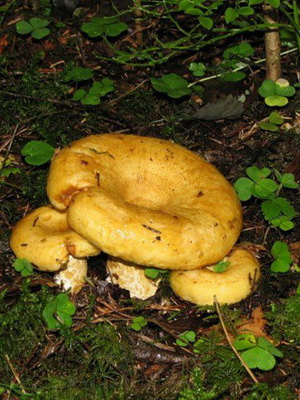
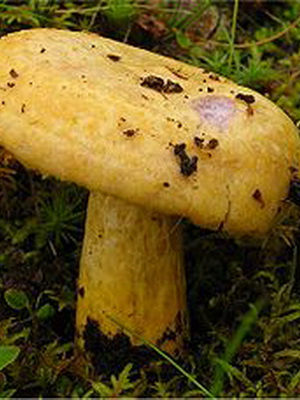
Pay attention to the photo of a yellow breast, its leg is 5-12 cm high with characteristic bright yellow pits or indentations, sticky and sticky, very strong, hollow. Blades: frequent, usually with brown spots in adult mushrooms
Plates: frequent, usually with brown spots in adult mushrooms.
Pulp: white, but turns yellow on cut and on contact with air, like thick milky juice. It has a weak but very pleasant fruity aroma.
According to the description, the yellow milk mushroom is very similar to the fringed milk (Lactarius citriolens), purple (Lactarius repraesentaneus) and real (Lactarius resimus). Fringed breast milk differs from yellow in that it grows exclusively in deciduous forests and, like the real one, does not have dents on the leg. And the inedible purple breast has lilac-colored milky juice.
When it grows: from mid-July to early October in temperate countries of the Eurasian continent.
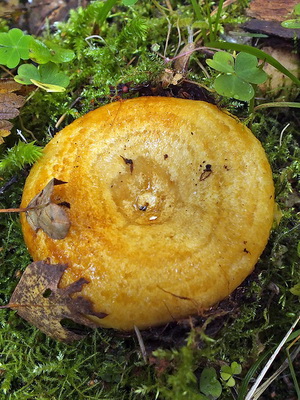

This type of mushroom can be found on the limestone soils of coniferous forests, less often next to birches.
Eating: Russian mushroom pickers consider it a very tasty mushroom, use it after preliminary soaking and boiling.
Application in traditional medicine (data have not been confirmed and have not undergone clinical studies!): In the form of a decoction as a means of combating gallstone disease.


